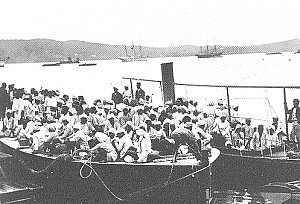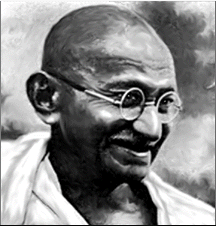In the 1860s large numbers
of Indians were recruited to work on the sugar
cane farms.
Although most came on a fixed term indenture
basis, others called 'passenger Indians' came to
trade and now form a major part of Durban's
community.
Nach 1860 wurden sehr viele
Inder zur Arbeit auf südafrikanischen
Zuckerrohr-Plantagen verpflichtet. Neben jenen
mit befristeten Arbeitsverträgen kamen auch
immer mehr Händler aus Indien. Ihre Nachkommen
formen heute den grössten Anteil der
Einwohnerschaft Durbans. |
|
 |
| |
|
|

Wie
die Schwarzen, so bekamen die Inder ein Leben wie
Menschen dritter Klasse zugewiesen. Eine
Erfahrung, die 1893 ein junger Rechtsanwalt aus
Indien machte, der als eine der bedeutendsten
Persönlichkeiten, die das 20. Jh. kennt, in die
Geschichte eingehen sollte:
Mahatma
Gandhi |
|
Gandhi
(1869-1948), also known as Mahatma Gandhi, was
born in Porbandar in the present state of Gujarat
on October 2, 1869, and educated in law at
University College, London. In 1891, after having
been admitted to the British bar, Gandhi returned
to India and attempted to establish a law
practice in Bombay, with little success. Two
years later an Indian firm with interests in
South Africa retained him as legal adviser in its
office in Durban. Arriving in Durban, Gandhi
found himself treated as a member of an inferior
race. He was appalled at the widespread denial of
civil liberties and political rights to Indian
immigrants to South Africa. He threw himself into
the struggle for elementary rights for Indians.
Passive Resistance Gandhi remained in South
Africa for 20 years, suffering imprisonment many
times. In 1896, after being attacked and beaten
by white South Africans, Gandhi began to teach a
policy of passive resistance to, and
non-cooperation with, the South African
authorities.
GANDHI
AND SOUTH AFRICA |
| |
|
|
|
|
|
There
are almost a million Indians living in South
Africa, the largest group outside of India and
Pakistan. Indians make up only 2% of South
Africa's population but they have a high profile,
particularly in KwaZulu-Natal, where Mahatma
Gandhi once lived and which continues to have the
biggest concentration of Indians.
Longstanding tension led to anti-Indian riots in
Durban in the 1950s, in which dozens of people
were killed.
Gegenwärtig leben etwa
eine Million Inder in Südafrika, das ist die
grösste Gruppe ausserhalb Indiens und Pakistans.
Inder machen 2% der südafrikanischen
Bevölkerung aus, aber sie sind prominent vor
allem in KwaZulu-Natal vertreten, wo einst
Mahatma Gandhi lebte.
Anhaltende Spannungen führten in den Fünfziger
Jahren zu anti-indischen Ausschreitungen mit
zahlreichen Todesopfern. |
|